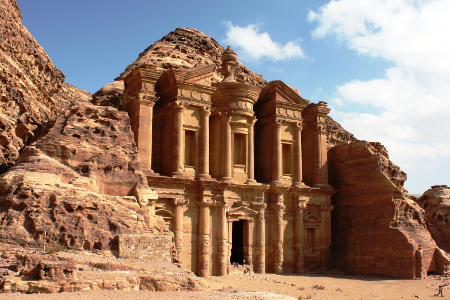Next Wonder ➥
Petra, originally known as Raqmu to the Nabataeans, is a historical and archaeological city in the southern Jordanian governorate of Ma'an that is famous for its rock-cut architecture and water conduit system. Another name for Petra is the Rose City due to the color of the stone out of which it is carved.

Established possibly as early as 312 BC as the capital city of the Arab Nabataeans, it is a symbol of Jordan, as well as Jordan's most-visited tourist attraction. It lies on the slope of Jebel al-Madhbah (identified by some as the biblical Mount Hor) in a basin among the mountains which form the eastern flank of Arabah (Wadi Araba), the large valley running from the Dead Sea to the Gulf of Aqaba. Petra has been a UNESCO World Heritage Site since 1985.
The site remained unknown to the western world until 1812, when it was introduced by Johann Ludwig Burckhardt. It was described as "a rose-red city half as old as time" in a Prize-winning poem by John William Burgon. UNESCO has described it as "one of the most precious cultural properties of man's cultural heritage". Petra was named amongst the New7Wonders of the World and was also chosen by the Smithsonian Magazine as one of the "28 Places to See Before You Die".
The site suffers from a host of threats, including collapse of ancient structures, erosion due to flooding and improper rainwater drainage, weathering from salt upwelling, improper restoration of ancient structures, and unsustainable tourism. The last has increased substantially, especially since the site received widespread media coverage in 2007 during the New Seven Wonders of the World Internet and cell phone campaign.